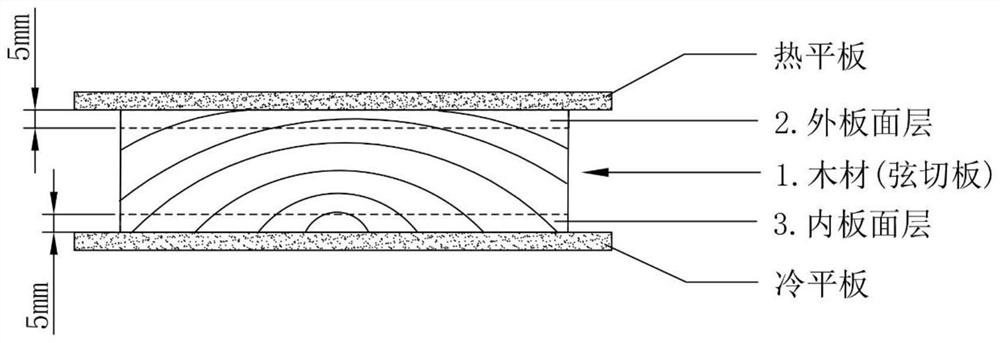A kind of environment-friendly stable wood and its surface thermal modification method
A stable, heat-modified technology, applied in wood heating, wood treatment, wood layered products, etc., can solve the problems of the chord-radial shrinkage ratio of polluted modified wood, and achieve improved dimensional stability and decorative performance, Effect of improving dimensional stability and improving stability
- Summary
- Abstract
- Description
- Claims
- Application Information
AI Technical Summary
Problems solved by technology
Method used
Image
Examples
Embodiment 1
[0032] In this example, Thai rubber wood is modified, and the rubber wood used is a string-cut board, β 1 is 25°, β 2 It is 70°, the chord radial shrinkage ratio is 2.14, and the initial moisture content is 0%.
[0033] (1) Preheating: the hot plate is heated up to the target temperature of 280°C, and the temperature is stabilized at the target temperature of 280°C, and the temperature of the cold plate is 60°C.
[0034] (2) Feeding: Push the Thai rubber wood into the cold and hot plates, and let the outer surface of the wood be in contact with the hot plate, and the inner surface of the wood be in contact with the cold plate, and the wood is pushed in for 3 seconds.
[0035] (3) Insulation: After the wood is pushed into the cold and hot plates, close the heat plate, make the heat plate contact with the surface of the wood outer plate for heat treatment, keep the target temperature of the heat plate at 280°C, and keep the temperature of the cold plate at 60°C; apply a pressur...
Embodiment 2
[0041] The rubber wood used in this embodiment is a string cut board, β 1 is 20°, β 2 It is 65°, the shrinkage ratio of chord and radial direction is 1.98, and the initial moisture content is 2%.
[0042] (1) Preheating: heat up the hot plate to the target temperature of 290°C, stabilize the temperature at the target temperature of 290°C, and keep the temperature of the cold plate at 65°C.
[0043] (2) Feeding: Push the wood into the cold and hot plates, and let the outer surface of the wood contact the hot plate, and the inner surface of the wood contact the cold plate. The time for pushing the wood is 3 seconds.
[0044] (3) Heat preservation: After the wood is pushed into the cold and hot plates, close the heat plate, make the heat treatment in contact with the surface of the wood outer plate, keep the target temperature of the heat plate at 290°C, and keep the temperature of the cold plate at 70°C; apply a pressure of 0.2MPa, to ensure that the hot plate is closely attac...
Embodiment 3
[0048] The Mandshurica mandshurica used in this embodiment is a string cutting board, β 1 is 27°, β 2 It is 64°, the chord radial shrinkage ratio is 1.83, and the initial moisture content is 2%.
[0049] (1) Preheating: the hot plate is heated to the target temperature of 270°C, and the temperature is stabilized at the target temperature of 290°C, and the temperature of the cold plate is 80°C.
[0050] (2) Feeding: push the wood of Mandshurica mandshurica into the cold and hot plates, and allow the outer surface of the wood to contact the hot plate, and the inner surface of the wood to contact the cold plate, and the time for pushing the wood is 3 seconds .
[0051] (3) Heat preservation: after the wood is pushed into the cold and hot plates, close the heat plate, make the heat plate contact with the surface layer of the wood outer plate for heat treatment, keep the target temperature of the heat plate at 290°C, and keep the temperature of the cold plate at 80°C; apply a pre...
PUM
| Property | Measurement | Unit |
|---|---|---|
| thickness | aaaaa | aaaaa |
Abstract
Description
Claims
Application Information
 Login to View More
Login to View More - R&D
- Intellectual Property
- Life Sciences
- Materials
- Tech Scout
- Unparalleled Data Quality
- Higher Quality Content
- 60% Fewer Hallucinations
Browse by: Latest US Patents, China's latest patents, Technical Efficacy Thesaurus, Application Domain, Technology Topic, Popular Technical Reports.
© 2025 PatSnap. All rights reserved.Legal|Privacy policy|Modern Slavery Act Transparency Statement|Sitemap|About US| Contact US: help@patsnap.com



